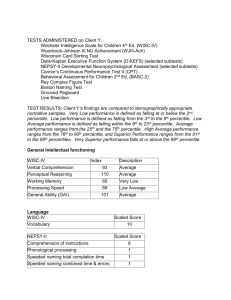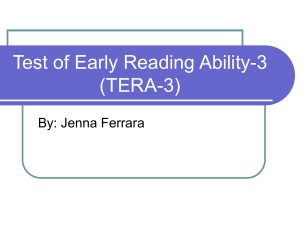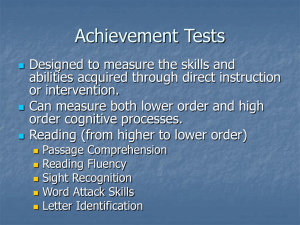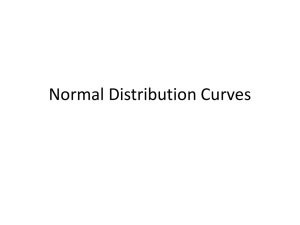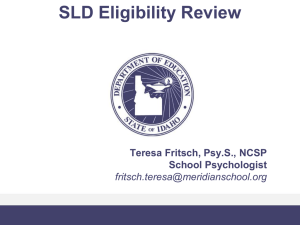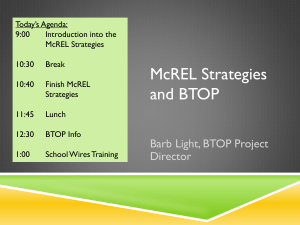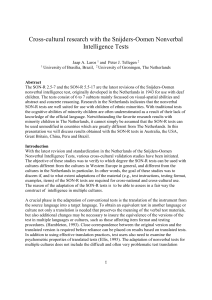Handout 1 - Hempstead & Associates
advertisement
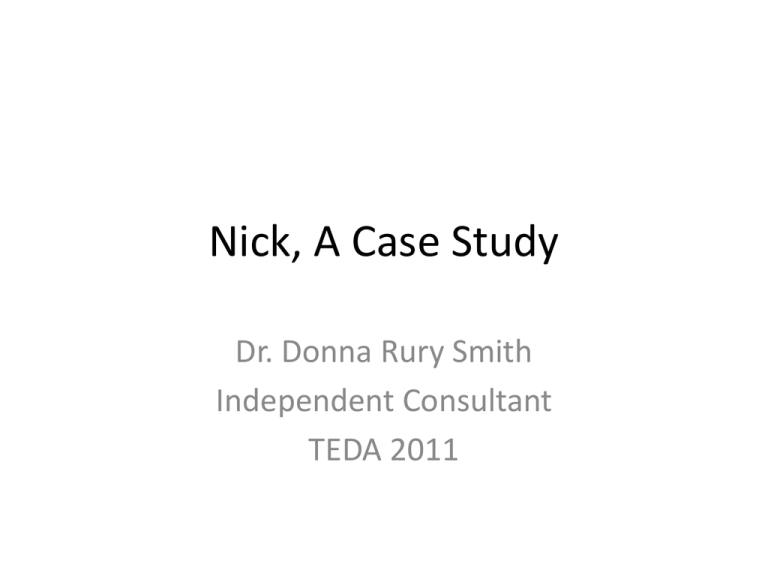
Nick, A Case Study Dr. Donna Rury Smith Independent Consultant TEDA 2011 Let Me Introduce You to Nick • 10:10 year-old, 4th grader • Referred in March by the SAT because of failing math grades and concerns of math teacher, Mr. Sosa • Had been identified on benchmark as “at-risk” in the fall for math-related difficulties (both calculation and problem solving CBM scores in bottom 20%) • According to his teacher, he consistently performs below grade level • Math performance is inconsistent with other content areas where he makes B’s and C’s Family History • Only child, lives with both parents • English is only language spoken in the home • Mother reports that developmental milestones were met as expected and he is in good health • He has asthma and uses inhaler (no more than 5 x month usually) • Mother reports that math was difficult for her, graduated 2 year college • Father is a college graduate, reports no learning difficulties, and is a banker Additional Parent Information • Parents describe Nick as easy-going, has friends • He plays soccer in city league and is in Boy Scouts • They are concerned about his frustration and the excessive amount of time being spent on homework • Early math skills/concepts were difficult for Nick to master Academic History • Kindergarten and 1st grade in another state • Started on this campus in grade 2 • Never retained, but summer school for math after 2nd and 3rd grades • Mr. Sosa indicates that he began 4th grade already behind in math Tier 1 • After first 6 weeks, Mr. Sosa began small group instruction for 10 min per day. • Primary focus was on getting help with homework for the day. • Performance was “erratic”. • Late November, was referred to SAT because of “minimal progress”. • SAT recommended after-school tutoring 2 x week for 30 min each session Tier 2 • In December began after-school tutoring with another math teacher, Mrs. Martinez. • Focus was on helping him complete homework with more supervision. • Added weekly progress monitoring. • PM data revealed very slow progress against target. • Also very slow progress in comparison to others in tutoring group. • Mid-year benchmark showed exceptionally slow progress and a widening achievement gap. Tier 2 Modified • Tutoring was increased to 3 x week, 30 min sessions with Mrs. Martinez. • She administered Key-Math 3 Diagnostic Assmt to identify his specific skill deficits. • Results showed several deficits from previous grades across a broad range of concepts and applications. • She used test results to direct intervention which now focused on remediating missing skills. • Progress monitoring shows progress is steady but still slow. Achievement gap is not being closed in such a way that he will be on grade level at end of year. Intervention Time Line mid Oct. Failing 1st 6 wks AW benchmark in bottom 20% Nov. Tier 1 Teacherled small group Dec. Failed 2nd 6 wks Referred to SAT Tier 2 Tutoring 2 x week PM shows very slow progress Jan. Feb. Still failing Gave Key Math diagnostic Referral made for testing Tier 2 changed to remediatio n with math specialist 15 min daily IAP developed PM shows steady but slow progress IEP is developed and Tier 3 begins Increased Tutoring to 3 x week AW benchmark still bottom 20% PM shows slow progress Mar. Assessment identifies SLD Apr. What Does Nick Have to Say • He says he “can’t do math”. • He believes he is so far behind he can never catch up. • He doesn’t want to go to summer school because he doesn’t think it will help. • He enjoys the math video games he has been playing in tutoring. • He is very distressed about the amount of time spent on homework each night. • He reports he likes science class. Classroom Observation • During math class • Review lesson on adding fractions with unlike denominators • Mr. Sosa demonstrated process and discussed how to apply the skill to solve real-world problems. • Nick sat at front of the room, appeared to be engaged, did not ask or answer any questions. • Students assigned 5 word problems to complete in 10 min. Nick spent all time working at his desk. • When asked the answer to Q 1, Nick mumbled something, then said “I don’t know.” • His paper revealed that he had tried to draw out each fraction using pie charts, but could not perform any calculation. Observations During Testing • Was attentive and on-task • Responded well to encouragement although initial response was to give up easily • Was not impulsive, but was limited by the number of alternative solutions or strategies • Relied on verbal rehearsal to recall new information • Was unable to explain his reasoning or strategy when asked Key Math 3 Data Composite Standard Score Percentile Rank Basic Concepts 79 8 Operations 78 7 Applications 83 13 Total Composite 79 8 Standard Score Percentile Rank Numeration 7 16 Algebra 7 16 Geometry 7 16 Measurement 5 5 Data Analysis & Probability 6 9 Basic Concept Subtests Key Math 3 Data Operations Subtests Standard Score Percentile Rank Mental Computation & Estimation 7 16 Addition & Subtraction 6 9 Multiplication & Division 5 5 Standard Score Percentile Rank Foundations of Problem Solving 7 16 Applied Problem Solving 6 9 Applications Subtests Assessment Plan • WIAT III: Math Problem Solving, Numerical Operations, Math Fluency • WISC-IV • WISC-IV Integrated: Visual Span, Spatial Span • NEPSY II: Memory for Designs, Design Copying, Picture Puzzles, Geometric Puzzles • PAL II: Part-Whole Relationships, Finding the Bug, Quantitative Working Memory, Spatial Working Memory, Rapid Automatic Switching WISC-IV Results Index Standard Score Range 90% CI Percentile Rank Verbal Comprehension 99 93-105 47 Perceptual Reasoning 86 81-94 18 Working Memory 86 81-94 18 Processing Speed 85 79-94 16 Full Scale 87 83-92 19 Subtests Scaled Score Percentile Similarities 9 37 Vocabulary 11 63 Comprehension 10 50 Block Design 8 25 Picture Concepts 7 16 Matrix Reasoning 8 25 Digit Span 7 16 Letter-Number Sequencing 8 25 Coding 7 16 Symbol Search 8 25 Cancellation 7 16 WISC-IV Integrated Results WM Registration Subtests Scaled Score Percentile Digit Span Forward 8 25 Visual Digit Span 7 16 Spatial Span Forward 6 9 Scaled Score Percentile Digit Span Backward 7 16 Spatial Span Backward 6 9 WM Manipulation Subtests There are no discrepancies between registration or manipulation subtests. There is no discrepancy between registration and manipulation subtests. NEPSY II Results Subtests Scaled Score Percentile Memory for Designs Immediate Content 7 16 Memory for Designs Immediate Spatial 8 25 Memory for Designs Immediate 7 16 Scaled Score Percentile Memory for Designs Delayed Content 5 5 Memory for Designs Delayed Spatial 3 1 Memory for Designs Delayed 6 9 Subtests NEPSY II Results Subtests Scaled Score Percentile Design Copying 7 16 Picture Puzzles 9 37 Geometric Puzzles 8 25 PAL II Results Part-Whole Subtest Scaled Score Percentile Part-Whole Relationships Composite 7 16 Part-Whole Concepts 7 16 Part-Whole Fractions and Mixed Numbers 10 50 Part-Whole Time 6 9 Scaled Score Percentile Finding the Bug 6 9 Multi-Step Problem Solving 7 16 Quantitative WM 6 9 Spatial WM Oral 7 16 Spatial WM Drawing 6 9 Other Subtests PAL II Results RAN Subtest Scaled Score Percentile Single Digits Total Time 8 25 Double Digits Total Time 8 25 Scaled Score Percentile 5 5 RAS Words & Digits Subtest Words & Digits Total Time WIAT III Math Results Subtests Standard Score Percentile Math Problem Solving 76 5 Numerical Operations 79 8 Math Fluency-Addition 72 3 Math Fluency-Subtraction 70 2 Math Fluency-Multiplication 68 2 Referral Questions to Answer 1. Why has Nick not responded to intervention? 2. Is he a student with a disability that requires additional support or instruction not available through general education? 3. How does he learn? What do we know about his unique learning needs? 4. What needs to change in his instructional program to produce better outcomes? Pattern of Strengths and Weaknesses • Identified cognitive strengths include: – – – – Verbal fluid reasoning Lexical and semantic knowledge Oral expression Others? • Identified cognitive weaknesses include: – – – – – – Nonverbal concept formation and fluid reasoning Visual-spatial organization and imaging Abstract, categorical or sequential reasoning Working memory Slow processing speed (especially with verbal info) Others? Pattern of Strengths and Weaknesses • Identified processing deficits specific to math include: – Rapid automatic switching – Quantitative and spatial working memory – Executive functions of sustained and switching attention, multi-tasking, and self-monitoring • Identified math-specific skill deficits – – – – Lack of automaticity for number fact retrieval Understanding of part-whole relationships Knowledge of algorithms for complex problem solving Use of adaptive strategies to solve math problems What would you recommend? Thanks for Your Participation Dr. Donna Rury Smith Based in Fort Worth Txdocsmith@gmail.com

